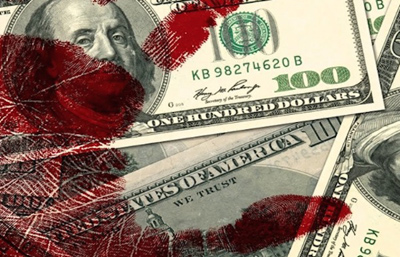Another Step Towards Collapse of Petrodollar
Rory Hall
 For the past year and half a major topic throughout the alternative press has been the new Chinese oil futures contract settled/priced in yuan. The fact that China is directly challenging the Federal Reserve Note, U.S. dollar, is quiet a significant change. For those that have been paying attention this new futures oil contract is nothing more than the next step in China moving completely away from the Federal Reserve Note, and the “world reserve currency” system and towards a multi-polar world with several currencies being used for international trade. For the past year and half a major topic throughout the alternative press has been the new Chinese oil futures contract settled/priced in yuan. The fact that China is directly challenging the Federal Reserve Note, U.S. dollar, is quiet a significant change. For those that have been paying attention this new futures oil contract is nothing more than the next step in China moving completely away from the Federal Reserve Note, and the “world reserve currency” system and towards a multi-polar world with several currencies being used for international trade.
Ken Schortgen, Jr., The Daily Economist, recently penned an article about Nigeria approving a currency swap agreement with China, stating,
It has been a little more than a month since China officially began offering oil futures contracts denominated in the Yuan currency, but early results continue to be positive for this contract to over time take more and more market share from the West and the Petrodollar. And with Iran, Qatar, and even Venezuela having already agreed to buy and sell their oil in currencies other than the dollar, a new currency swap agreement signed on May 3 between Nigeria and China could mean that a fourth OPEC nation could also soon be leaving the Petrodollar.
The Central Bank of Nigeria (CBN) has signed a currency swap deal worth about $2.5 billion with the People’s Bank of China to provide adequate local currency liquidity for transactions between national businesses, The Punch newspaper reported on Thursday, citing a high-ranking official from the Central Bank of Nigeria (CBN). Sputnik News
The Daily Economist
While China pursued currency swaps as far back as 1997, during the “Asian financial crisis”, none of the agreements were ever activated. That all changed with the global financial meltdown in 2008. China began actively pursuing, and instituting, direct currency swaps and even went so far as to open “Renminbi Clearing Centers” around the world including Canada, the backyard of the U.S..
Beyond the moderate progress in Asian regional financial cooperation, China has signed swap agreements with approximately 30 countries since 2008 (see Table 1). The People’s Bank of China (PBOC) stated that those swap agreements were intended not only to “stabilize the international financial market,” but also to “facilitate bilateral trade and investment.”
Table 1: China’s swap agreements and its counterparties
| # |
Countries |
Signing Date |
Swap Amount (RMB billion) |
Trade volume (RMB billion) |
RMB Clearing Center |
RQFII |
| 1 |
Belarus |
May 2015 |
7 |
8.94 |
|
|
| 2 |
Malaysia |
Apr 2015 |
180 |
652.66 |
√ |
|
| 3 |
South Africa |
Apr 2015 |
30 |
401.25 |
|
|
| 4 |
Australia |
Apr 2015 |
200 |
839.84 |
√ |
√ |
| 5 |
Armenia |
Mar 2015 |
1 |
1.19 |
|
|
| 6 |
Suriname |
Mar 2015 |
1 |
1.24 |
|
|
| 7 |
Pakistan |
Dec 2014 |
10 |
87.46 |
|
|
| 8 |
Thailand |
Dec 2014 |
70 |
438.29 |
√ |
|
| 9 |
Kazakhstan |
Dec 2014 |
7 |
175.93 |
|
|
| 10 |
Hong Kong |
Nov 2014 |
400 |
2,465.25 |
√ |
|
| 11 |
Canada |
Nov 2014 |
200 |
335.01 |
√ |
√ |
| 12 |
Qatar |
Nov 2014 |
35 |
62.60 |
√ |
√ |
| 13 |
Russia |
Oct 2014 |
150 |
549.15 |
|
|
| 14 |
South Korea |
Oct 2014 |
360 |
1,687.19 |
|
|
| 15 |
Sri Lanka |
Sep 2014 |
10 |
22.27 |
|
|
| 16 |
Mongolia |
Aug 2014 |
15 |
36.66 |
|
|
| 17 |
Switzerland |
July 2014 |
150 |
367.42 |
√ |
√ |
| 18 |
Argentina |
July 2014 |
70 |
91.28 |
|
|
| 19 |
New Zealand |
Apr 2014 |
25 |
76.20 |
|
|
| 20 |
EU |
Oct 2013 |
350 |
N.A. |
|
|
| 21 |
Iceland |
Sep 2013 |
3.5 |
1.37 |
|
|
| 22 |
Albania |
Sep 2013 |
2 |
3.44 |
|
|
| 23 |
Hungary |
Sep 2013 |
10 |
51.72 |
|
|
| 24 |
UK |
Jun 2013 |
200 |
430.79 |
√ |
|
| 25 |
Brazil |
Jun 2013 |
190 |
554.90 |
|
|
| 26 |
Singapore |
Mar 2013 |
300 |
466.94 |
√ |
|
| 27 |
Ukraine |
Jun 2012 |
15 |
68.43 |
|
|
| 28 |
Turkey |
Feb 2012 |
10 |
136.79 |
|
|
| 29 |
UAE |
Jan 2012 |
35 |
284.45 |
|
|
| 30 |
Uzbekistan |
Apr 2011 |
0.7 |
28.00 |
|
|
| 31 |
Indonesia |
Mar 2009 |
100 |
420.54 |
|
|
| Total |
– |
3,137.2 |
10,747.2 |
– |
– |
CogitAsia
The chart above, from CogitAsia, was produced in 2015 and does include Japan, Nigeria or France all of which are conducting direct currency swaps with China. All three nations bring something unique, economically speaking, to the table that will prove beneficial for both sides of the trade.
China now has direct currency swaps with more than 30 nations, including some of the largest economies in the world, like Japan, France, Australia to name but a few. This is all part and parcel to circumventing the world reserve currency system which punishes other nations, while at the same time strengthens the U.S. economy. What’s terrible for the rest of the world is awesome for the U.S..
China, along with a great many other nations, are ready for this system to change and balance the economic scale. When you announce to the world that your currency is someone else’s problem, the people that have the problem usually find a way to mend the problem and eliminate the situation creating the problem.
Even the gloomiest pessimists accept that a steep dollar depreciation would inflict more suffering on China and other Asian economies than on the United States. John Snow’s counterpart in the Nixon administration once told his European counterparts that “the dollar is our currency, but your problem.” Snow could say the same to Asians today. If the dollar fell by a third against the renminbi, according to Nouriel Roubini, an economist at New York University, the People’s Bank of China could suffer a capital loss equivalent to 10 percent of China’s gross domestic product. For that reason alone, the P.B.O.C. has every reason to carry on printing renminbi in order to buy dollars. NY Times
This is exactly where we stand today. China, along with Russia, understand this scenario all too well. These two nations, along with 30+ other nations, are making moves to be rid of the problem known as the Federal Reserve Note, U.S. dollar. Once this “problem” is corrected the U.S. economy will change dramatically. Inflation, and according to some economist like John Williams of Shadow Stats, hyperinflation will reign down on the U.S. economy like the world has never seen or experienced before. At this juncture we can only hope cooler heads prevail and a major war doesn’t manifest to announce the coming change in our global monetary system.

Rory Hall, The Daily Coin. Beginning in 1987 Rory has written over 1,000 articles and produced more than 300 videos on topics ranging from the precious metals market, economic and monetary policies, preparedness as well as geopolitical events. His articles have been published by Zerohedge, SHTFPlan, Sprott Money, GoldSilver, Silver Doctors, SGTReport, and a great many more. Rory was a producer and daily contributor at SGTReport between 2012 and 2014. He has interviewed experts such as Dr. Paul Craig Roberts, Dr. Marc Faber, Eric Sprott, Gerald Celente and Peter Schiff, to name but a few. Don't forget to visit The Daily Coin and Shadow of Truth YouTube channels to enjoy original videos and some of the best economic, precious metals, geopolitical and preparedness news from around the world.
thedailycoin.org
|




